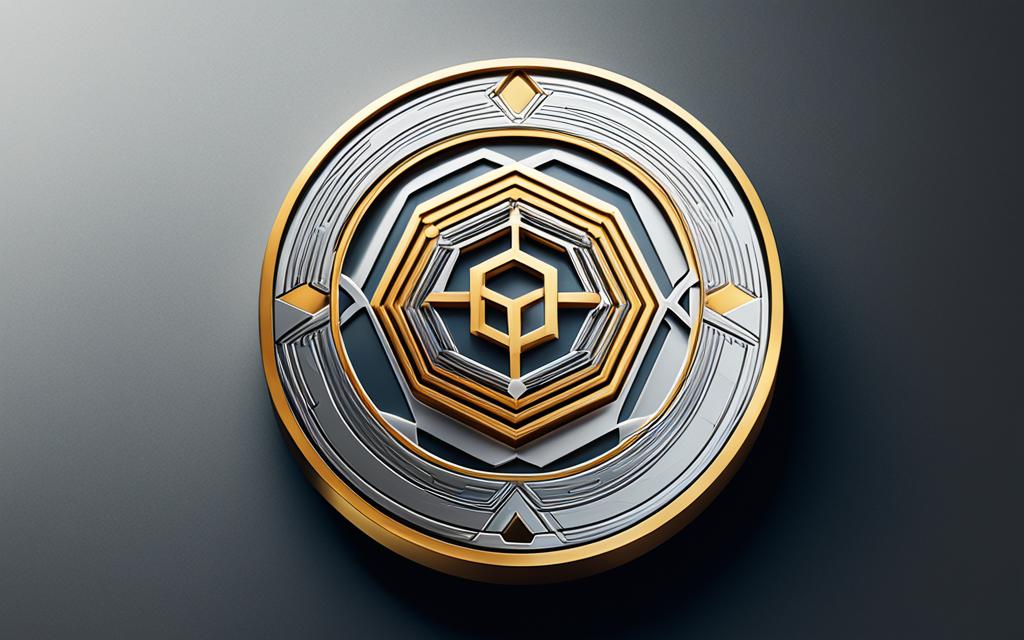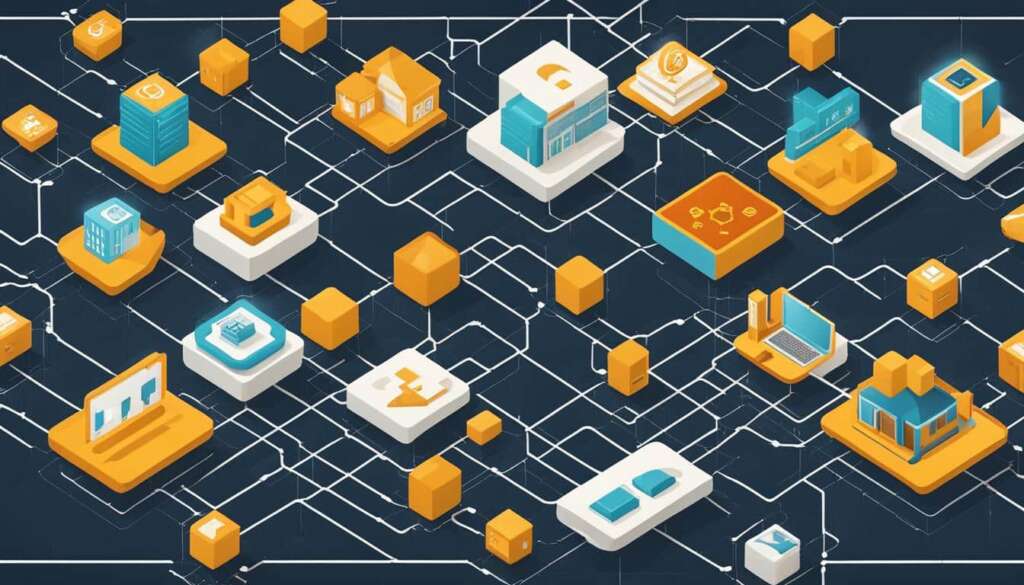Table of Contents
In this series, we’ll dive into Metal Blockchain’s key elements and functions. We’ll explore concepts like Layer 0, the history of consensus, and Avalanche protocols. Plus, we’ll look into a blockchain’s path on Metal Blockchain, its key parts, and the $METAL token. We’ll talk about how Metal Blockchain uses decentralized governance, too.
Key Takeaways:
- Metal Blockchain employs Avalanche protocols, the latest advancement in consensus technology1.
- Layer 0 Blockchain serves as the underlying infrastructure, ensuring high scalability, security, and decentralization1.
- Metal Blockchain consists of various components such as the Virtual Machine, Subnets, and the $METAL token1.
- Layer 1 Blockchain provides core features like asset creation, smart contract execution, and maintaining a decentralized ledger1.
- Staking on the Metal Blockchain requires a minimum of 2,000 METAL tokens and offers annual rewards ranging between 10% to 12%2.
What is Metal Blockchain?
Metal Blockchain is a revolutionary technology at its core. It transforms finance with new ideas about blockchain. This tech makes payments easier and more secure for everyone involved3. People save time and money by using Metal Blockchain in their work3. It lets banks and shops update how they take payments, moving the industry forward3. Leaders like Fiserv see Metal Blockchain’s big benefits3.
Metal Blockchain leads layer zero advancements in finance. It focuses on better digital payments and IDs4. The company runs a program that brings credit unions together to improve the field4. With Pete Nohelty from Vibrant Credit Union giving advice, Metal Blockchain gets even stronger4.
The great thing about Metal Blockchain is how well it works with others. It can connect easily to different blockchains, solving a big problem. It’s super fast, processing thousands of transactions in a flash5. Metal Blockchain can grow with demand, handling more transactions easily5. And, it’s compatible with popular Ethereum tools, making moving apps easy5.
Metal Blockchain has its special coin, $METAL. This coin is key to its system and grows more valuable over time. With 666,666,666 coins, its value increases because fewer coins will be available5. Right now, 6% of these coins are out there, but more will come. The Metal world also includes $XPR, used for many things, and MetalPay. This app lets people spend their crypto easily5. There’s also a stablecoin, $XMD, backed by Metal DAO. It adds more ways to use the Metal system5. The team behind Metal knows a lot about crypto and finance. They make sure Metal Blockchain meets high standards for use in finance, like the Bank Secrecy Act5.
Layer 0 Blockchain and Its Role
In the world of blockchain, a layer 0 blockchain is the key system that supports the network. It involves many protocols, links, validators, and parts that make the system work well. Metal Blockchain uses this system to offer a strong and big platform for its users.
It is the foundation that supports the whole blockchain world, making sure it can grow and stay secure. This layer is very important for Metal Blockchain. It helps solve problems that come up in traditional finance systems.
Being able to grow is important for a blockchain platform like Metal Blockchain. It uses special Avalanche protocols to increase its size. This lets Metal Blockchain work well even with lots of transactions1.
Keeping things safe is a big deal for any blockchain. Metal Blockchain makes sure its system is safe from the start. It uses strong links between its users, safe Virtual Machine (VM) tech, and the latest ways to decide things together. This keeps the data safe and unchangeable1.
Making sure no single group controls everything is key in blockchain. The layer 0 of Metal Blockchain helps spread the power. It lets different parts of the network work together. This makes Metal Blockchain more fair and diverse1.
Using the layer 0 system, Metal Blockchain lets people build DApps, tokens, and new blockchains. This opens up lots of chances for making amazing things. People can use Metal Blockchain to try out new ideas and make the most of blockchain tech1.
The layer 0 blockchain is at the heart of Metal Blockchain. It helps keep the system growing, safe, and shared. It’s the main tech of Metal Blockchain, making it useful for banks, fintech firms, and big companies6. Metal’s way is to focus on what its users need, keep to the rules, and keep making things better. Metallicus and Metal Blockchain want to change finance and offer great solutions for their clients6.
Layer 1, Layer 2, and Layer 3 Blockchains
Blockchain technology has grown to cope with needs like scalability and performance. It’s sorted into layers, each with its special features. This helps with scalability and lets different layers work together. Let’s look into what makes Layer 1, Layer 2, and Layer 3 blockchains special.
Layer 1 Blockchain
Layer 1 blockchains are the base layer, offering essential services and features.
In layer 1, transactions go directly onto the main chain. They use things like Proof-of-Work or Proof-of-Stake for security. These blockchains do things like creating assets, running smart contracts, and keeping the network safe7.
Layer 1 is key for trust and keeping things decentralized. Big projects here include Bitcoin and Ethereum. But, they face issues with handling lots of transactions fast because of how they’re set up.
Layer 2 Blockchain
Layer 2 blockchains build on layer 1 to get past scaling and performance problems.
Layer 2 aims to make layer 1 more scalable. It does it by handling some transactions off the main chain. This way, it boosts the network’s performance without risking security. They use new ways to agree on transactions that are different from Proof-of-Work or Proof-of-Stake7.
Layer 2 uses methods like sharding and sidechains to make transactions quicker and cheaper. This makes blockchain more practical for lots of daily uses. Good examples here are projects like Lightning Network for Bitcoin and Plasma for Ethereum.
Layer 3 Blockchain
Layer 3 blockchains sit on top of layer 2, offering special functions for certain uses.
Layer 3 blockchains offer special services for different uses and industries. They use what layer 2 provides to make specific blockchain uses better. This includes areas like DeFi, supply chains, and verifying identities7.
They’re making blockchain tech even more useful. Projects like Polkadot and Cardano help blockchains work together better. This makes a web of connected blockchains.
All three layers together form a system that meets the needs of many fields. Each layer has its own role and helps blockchain tech grow and change7.
The Components of Metal Blockchain
Metal Blockchain has key parts working together to create a powerful platform.
At its core, Metal Blockchain uses a peer-to-peer network. This network makes talking between nodes safe and smooth. It keeps the whole system trustworthy.
The Virtual Machine (VM) is another key bit. It’s where smart contracts and code run. This creates a secure spot for developers to put out their apps, making the platform better.
The system’s agreement method is vital too. It helps make sure Metal Blockchain is safe and transactions are right. This way, the whole system is sound and can be trusted.
Metal Blockchain is unique because it’s split into parts called subnets. Each subnet works on its own part of the network, making everything run quicker and smoother. This design lets Metal Blockchain handle lots of transactions super fast.
The platform also looks great and is easy to use. The Metal logo shows this off, with one part for Metal Blockchain and another for the $METAL money8. The design uses a mix of 3D and 2D that’s clear and strong, giving users a great time.
It’s colourful too, with bright shades like Metal Pay Orange, Proton Purple, and Metallicus Green. This makes Metal Blockchain’s look lively and fun.
To sum up, Metal Blockchain’s parts, from the network to the design, work together well. They bring safety, speed, and a good feel to using the system. With these strong features, Metal Blockchain is changing the blockchain world for the better98.
$METAL Token and Tokenomics
The $METAL token is key to the Metal Blockchain system. It plays many roles that help everything run smoothly. It lets people take part in different actions.
The $METAL token is mainly used to pay for transaction fees on the Metal Blockchain. Every action on the network needs a fee, which must be paid in METAL. This system makes the token meaningful. It also keeps the network safe and strong. Using METAL for daily transactions encourages its use. This helps the Metal Blockchain to grow.

Caption: The $METAL token and its role in the Metal Blockchain ecosystem.
The Metal Blockchain adjusts its fees based on transaction type and complexity. This flexible fee system keeps the network quick and efficient, even when many people are using it. It means the Metal Blockchain can support many different uses, from simple to complex.
There’s a special part of how fees work called fee burns. When you pay your fees with METAL, those tokens get taken out of circulation forever. This is good because it means the total amount of METAL goes down over time. That could make METAL worth more, which is good for those who have it.
Besides paying for fees, people can also use METAL for staking on the Metal Blockchain. Staking involves putting your METAL away to help validate transactions and make the network more secure. Those who stake their tokens help to keep the Metal Blockchain open and safe. In return, they get rewards for their efforts.
Those checking and securing transactions on the Metal Blockchain need to stake at least 2,000 METAL10. They can stake for different lengths, from 14 days to a whole year. Validators must keep their services up at least 80% of the time to get rewards. Everyone who stakes, whether a big validator or a smaller delegator with 25 METAL, could earn something. This system encourages more people to join in and help keep the network safe and running smoothly.
To sum up, the $METAL token is crucial in the Metal Blockchain world. It’s needed for fees, helps with staking, and makes the network valuable. With its unique fee burning and fair staking rewards, the Metal Blockchain offers users chances to be part of something big. At the same time, they might even make a profit from their involvement.
Staking on Metal Blockchain
Staking is key in the Metal Blockchain. It lets users join the network’s Proof-of-Stake and earn rewards. By staking their tokens, users help secure and spread out the network.
Validators are vital. They check transactions and keep the network honest. A 2,000 METAL token stake is needed to become one, stopping tricks like Sybil attacks. To keep the network safe, validators can’t get too big11.
Delegators also support the network. They need just 25 METAL tokens. By picking trusted validators, they can stake easily without running their node11.
Both validators and delegators get rewards for staking. To earn, they must be up 80% of the time. Longer staking periods mean more rewards, encouraging commitment11.
Staked METAL tokens lock for 2 weeks to 1 year. This keeps the network safe by avoiding big changes due to too many tokens moving11.
Delegation fees are common. They start at 2%, set by validators. They must tell you how much they charge. But these don’t stop the great opportunity to stake11.
Staking your METAL lets you help run the network. It rewards you for making the network safer and more efficient. This way, you’re helping the Metal Blockchain to be better11.
Join the Metal Blockchain Staking Community
If you’re keen on staking with Metal Blockchain, stay connected with the community. Learn more by checking these sources:
- Introduction to Staking on the Metal
- The Metal Blockchain Staking FAQ
- Metal Blockchain Validator Staking Guide
These guides cover everything you need to know. For the latest, join the Metal Blockchain Telegram chat. You can also find out about staking METAL by asking in the Validators chat12.
Staking Rewards and Benefits
Staking with Metal Blockchain brings rewards. The current staking reward for METAL is 10 to 12% yearly. This is a great way to earn from your staked tokens12.
Validators can get extra rewards by staking more METAL. They need to stake five times more than their usual amount. This rule helps strengthen the network and makes it fairer12.
Delegators also win from staking. They get part of the rewards, with the rest going to validators as their fee. This system ensures fairness12.
Table: Staking on Metal Blockchain Minimum Requirements and Maximum Weights
| Staking Type | Minimum Amount | Maximum Amount/Weight | Minimum Staking Period | Maximum Staking Period |
|---|---|---|---|---|
| Validator | 2,000 METAL | 3 million METAL or 5 times the staked amount, whichever is lower13 | 2 weeks13 | 1 year13 |
| Delegator | 25 METAL | N/A | 2 weeks13 | 1 year13 |
Staking isn’t just about rewards. It makes the network safer and fairer. Validators and delegators keep the blockchain working well. They get rewarded, offering a great chance to be part of the Metal Blockchain13.
METAL Token Distribution
The METAL token system makes sure everyone has a fair share all over the community14.
There are 666,666,666 coins available, set out for different groups and users14.
Token Allocation
For the METAL Blockchain, tokens go to the Metal Foundation, founders, MTL conversion, and staking rewards14.
The founders get 71,000,000 METAL tokens. They must wait for 12 months before they can use them. This makes sure they stay committed to the project’s success14.
The Metal Foundation got 142,333,333 METAL tokens to develop and grow the network14.
There was an event where MTL community members could swap their Metal DAO tokens for METAL. This helped engage the community and made the process clear14.
Staking rewards help encourage taking part in the METAL world. 333,333,333 METAL coins will be given out over time. This encourages users to help secure and stabilize the network14.
Metal Blockchain(METAL) Startup Sale
Before it officially started, the Metal Blockchain(METAL) offered 68,027 METAL tokens for free. This was to introduce the project to its first supporters14.
Each person could only invest in 1000 shares. This made sure lots of people could take part14.
VIP users with over 500 USD in Spot Assets could join the sale. This rule welcomed many different investors to support the project14.
METAL Token and the Future of Blockchain
The METAL token connects old finance with new blockchain tech. It’s useful for both DeFi users and companies starting their own chains or dApps14.
Metal Blockchain(METAL) is moving from Proof-of-Work (like BTC and ETH) to Proof-of-Stake (PoS). This change makes things more scalable, saves energy, and improves security14.
The METAL system is growing and joining DeFi in exciting ways. Its way of sharing tokens and new blockchain tech are making a difference in how we use finance in the future.
| Token Distribution Ratio | Token Allocation |
|---|---|
| Foundation | 18.3% |
| Staking Reserved | 50% |
| Reserved for Conversion | 18% |
| Initial Staking for Securing the Chain | 3% |
| Founders | 10.7% |
Detailed Token Distribution Overview:14
- Metal Foundation: 18.3%
- Staking Reserved: 50%
- Reserved for Conversion: 18%
- Initial Staking for Securing the Chain: 3%
- Founders: 10.7%
Fee Burning and Fee Schedule
Transactions on the Metal Blockchain need a fee in METAL. This stops spam and keeps the network secure. These fees are key to keeping the blockchain’s integrity.
On the Metal Blockchain, fees are not just collected; they are burned. When users pay a fee, it’s destroyed. This makes the METAL tokens left more valuable over time.
Fee amounts change for different types of transactions. The C-Chain gas price algorithm sets these fees. It considers network use and changes fees accordingly.
If the network is busy, transaction fees go up to lessen the load. This makes transactions cheaper during quieter times. So, users save money when the network isn’t busy.
This system lets the Metal Blockchain handle changing demands well. It keeps pricing fair and efficient. Users are encouraged to time their transactions right. This helps create a better and bigger blockchain system.
The Metal Blockchain uses burning and a changing fee schedule. This makes transactions secure and efficient. It also helps the METAL token’s value grow in the long run15.
Validating Other Subnets on Metal Blockchain
Validators are key in the Metal Blockchain. They make sure the network is safe and works well. They check transactions and keep the blockchain secure. Validators help by working on the main network and by checking other parts of the Metal Blockchain, which makes the whole system better.
To be a validator, you must put up at least 2,000 METAL16. This rule makes sure validators are serious and do a good job. It helps keep the network strong and reliable.
Validators get rewards for staying online and working correctly. The Metal Blockchain uses smart ways to check if they do their job well, like proof-of-uptime and proof-of-correctness17. If validators are always right and work well, they get more METAL tokens. This makes them work hard and keep the network safe.
The Metal Blockchain lets validators check more than just the main network. It can have several subnets. Each of these can work a bit differently. These differences help meet the needs of different groups and tasks, such as fitting specific rules or working better for certain uses17.
When validators look after a part of the Metal Blockchain, they have to follow special rules. For example, they might need to be in a certain place or do some extra checks. These rules are there to keep everything running smoothly and correctly, especially in places with particular rules18.
Subnets can even have their way of using money and start their blockchains. This special freedom lets them focus on keeping data private and safe for groups and businesses that need it18. Validators make sure private areas stay that way, only letting in those who should be there.
To wrap up, the way the Metal Blockchain handles checks lets more people help. Validators need 2,000 METAL and work hard to get it right. Different parts of the Metal Blockchain can suit different needs, helping the whole system be stronger. This mix of options makes the Metal Blockchain a powerful and flexible place to work.
| Statistical Data | Reference |
|---|---|
| Metal Blockchain can process thousands of transactions per second, making it faster and more efficient than many other blockchain networks. | 17 |
| Each subnet in the Metal Blockchain can process 4,500 transactions per second, theoretically allowing for unlimited total transactions per second across all subnets. | 17 |
| Metal Blockchain has four built-in blockchains: the Proton Chain (A-Chain), the Platform Chain (P-Chain), the Contract Chain (C-Chain), and the Exchange Chain (X-Chain). | 17 |
| Proton Chain (A-Chain) allows for the creation of smart contracts using C++ and Typescript, implementing the Antelope Virtual Machine, and uses the Snowman consensus protocol. | 17 |
| The Contract Chain (C-Chain) allows the creation and use of smart contracts on the Metal Blockchain, using a modified version of the Ethereum Virtual Machine (EVM) and the Snowman consensus protocol. | 17 |
| The Platform Chain (P-Chain) manages subnets, coordinates validators, and enables cross-communication between internal blockchains, using the Snowman consensus protocol. | 17 |
| The Exchange Chain (X-Chain) allows for the creation and transfer of digital assets, using the Avalanche consensus protocol for network security. | 17 |
| Subnets in the Metal Blockchain network are independent entities that specify their own execution logic, fee structure, and networking, providing lower latency, higher TPS, and lower transaction costs. | 17 |
| Metal Blockchain subnets can define their own token economics, launch their blockchains with customized virtual machines, and comply with regulatory requirements as needed. | 17 |
| The subnet architecture in Metal Blockchain can support compliance by allowing subnets to require validators to meet specific regulatory requirements, such as KYC/AML checks or holding particular licenses. | 17 |
| Subnets in Metal Blockchain can be tailored to meet application-specific requirements, providing the necessary hardware capabilities for different types of applications. | 17 |
| Private subnets can be created in Metal Blockchain, limiting blockchain visibility to predefined validators only, ensuring data privacy and security for organizations. | 17 |
| The subnet architecture in Metal Blockchain allows for customization to create permissioned networks tailored to the specific needs of different organizations. | 17 |
| Staking on the Metal Blockchain requires validators to stake a minimum of 2,000 METAL to participate in the validation process. | 16 |
Conclusion
Metal Blockchain technology is exciting for the future of finance and digital insights. It focuses on layer zero principles. This makes it scalable, secure, and easy to use with other blockchain systems. This tech is being used by the Federal Reserve in a service called Fed Now. It can handle lots of transactions quickly and supports payments for everyone19.
It works well with current financial systems. This shows it can be part of the financial world easily. Metal Pay app gives rewards in MTL tokens for using it. This makes it more appealing to users20. Also, Blockdaemon provides dedicated servers to boost Metal Blockchain’s performance21.
Metal Blockchain comes with great features like Proof-of-Stake and rewards for staking. With its tie-up with Fed Now, it’s now a key player in quick payments. This shows how blockchain can change finance19. Metal Blockchain aims to challenge popular payment platforms. This includes Venmo, PayPal, AliPay, and WeChat Pay. It’s an exciting chance for those who invest or use it20.
Metal Blockchain is growing fast in tech and finance. Its skills, safety, and ability to connect with other systems are strong. It can change how we use digital money and banking. The future could bring even more amazing things for Metal Blockchain and its users1920.
FAQ
What is Metal Blockchain?
Metal Blockchain is a key technology for running different blockchains. It uses Snow protocols for setting up and agreeing on chains. This tech is made to be scalable, work with other systems easily, and use low energy. It changes how we use digital money and work with banks.
What is a layer 0 blockchain?
A layer 0 blockchain is the base of a blockchain setup. It includes all the needed parts like rules, links, machines, and checks for the network to run. For Metal Blockchain, this base layer supports growth, safety, and spreading control evenly.
What are layer 1, layer 2, and layer 3 blockchains?
Layer 1 is the central blockchain network, handling common tasks like making deals, running smart contracts, and keeping agreement across many. Layer 2 builds on layer 1, making things better and faster. Layer 3 then adds special tools for certain needs.
What are the components of Metal Blockchain?
Important Metal Blockchain parts are: a way for nodes to talk directly, a Virtual Machine for smart contracts, a process for making sure the network is safe, and a setup for different parts to work alone yet together.
What is the $METAL token?
The $METAL token belongs to Metal Blockchain. It’s used for paying fees, making the network safer by locking up tokens, and as a measure between subnetworks. When you pay fees using METAL, those tokens disappear, making the supply smaller.
How does staking work on Metal Blockchain?
Staking means putting your METAL tokens away to help check on the network. You need at least 2,000 METAL to do this. Or, you can let someone else do it with your tokens. This helps keep everything safe and working right. Those who help out get more tokens back if they leave their METAL there longer.
How is the METAL token distributed?
There will only ever be 666,666,666 METAL tokens. These tokens are shared among the Foundation, the leaders, for changing old tokens into METAL, and to thank those helping with the network. The leaders got 71,000,000 METAL, slowly getting it over 12 months. The Foundation got 142,333,333 METAL to grow and improve the network. Later on, 333,333,333 METAL tokens will be given as thanks for checking the network.
How does fee burning and the fee schedule work on Metal Blockchain?
To stop unwanted actions, moving money around on Metal Blockchain costs a little in METAL tokens. These tokens then go away, making the amount of METAL smaller each time you move money. The cost changes based on how busy the network is. If it’s too busy, moving money costs more. If it’s not that busy, it costs less.
Can validators validate other subnets on Metal Blockchain?
Yes, on Metal Blockchain, validators can look after different parts. They need at least 2,000 METAL. These parts can also use METAL as their local token. Validators get bonuses for being online and doing their job, which keeps the network safe and runs smoothly.
Source Links
- https://metalblockchain.org/news-insights/metal-blockchain-deep-dive-series – Metal Blockchain Deep Dive Series
- https://metalblockchain.org/news-insights/introducing-metal – Introducing $METAL
- https://www.metallicus.com/blog/metal-blockchain-integrates-credit-card-and-ach-processing-capabilities-with-payments-technology-from-global-leader-fiserv – Metal Blockchain Integrates Credit Card and ACH Processing Capabilities with Payments Technology from Global Leader Fiserv
- https://blocktelegraph.io/pete-nohelty-joins-metal-blockchain-as-advisor/ – Pete Nohelty Joins Metal Blockchain to Bridge the Worlds of Blockchain and Financial Services – Block Telegraph
- https://flagship.fyi/outposts/blockchains/big-banks-fednow-and-the-metal-blockchain/ – Breaking Barriers: Metal Blockchain’s FedNow Integration on the Path to Becoming the Leading Blockchain for Big Banks
- https://www.newsfilecorp.com/release/165778/Metal-Blockchain-Announces-Launch-of-Revolutionary-Layer-0-Technology-with-Builtin-BSA-Compliance – Metal Blockchain Announces Launch of Revolutionary Layer 0 Technology with Built-in BSA Compliance
- https://blockchainmagazine.net/your-ultimate-guide-to-layer-0-blockchains-and-how-do-they-work/ – Your Ultimate Guide To Layer 0 Blockchains And How Do They Work
- https://metalblockchain.org/news-insights/the-metal-blockchain-identity-a-vision-of-innovation-and-superior-design – The Metal Blockchain Identity
- https://test.smartsight.in/application/blockchain/what-is-a-metal-blockchain/ – What Is a Metal Blockchain?
- https://metalblockchain.org/news-insights/decentralized-independent-governance-model – Decentralized Governance Model
- https://metalblockchain.org/guides/introduction-to-staking-on-the-metal-blockchain – Introduction to staking on the Metal Blockchain – Metal Blockchain | Build The Blockchain Future
- https://metalblockchain.org/guides/the-metal-blockchain-staking-faq – The Metal Blockchain staking FAQ – Metal Blockchain | Build The Blockchain Future
- https://docs.metalblockchain.org/nodes/validate/staking – What is Staking? | Metal Docs
- https://www.gate.io/announcements/article/28121 – Gate.io Startup Free Offering: Metal Blockchain(METAL) and Announcement of Free Distribution Rules( 68,027 METAL free of charge)
- https://itif.org/publications/2019/04/30/policymakers-guide-blockchain/ – A Policymaker’s Guide to Blockchain
- https://www.thebigwhale.io/tokens/drunk-robots – What is Metal Blockchain?
- https://metalblockchain.org/news-insights/subnets-designed-for-scalability – Subnets: designed for scalability
- https://docs.metalblockchain.org/subnets – Subnets Overview | Metal Docs
- https://medium.com/@Zareh.L2/federal-reserve-embraces-metal-blockchain-for-fed-now-revolutionizing-instant-payments-7c8e8d3ea5d7 – Federal Reserve Embraces Metal Blockchain for Fed Now: Revolutionizing Instant Payments
- https://www.coinbureau.com/review/metal-mtl/ – Metal (MTL) Review: What You Need to Know | Beginnners Guide
- https://www.blockdaemon.com/blog/what-is-bare-metal-blockchain-infrastructure – What is Bare Metal Blockchain Infrastructure? — Blockdaemon Blog








